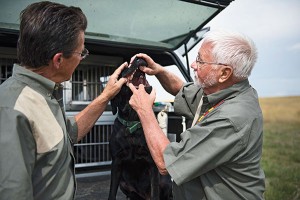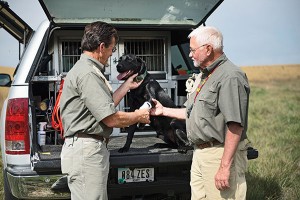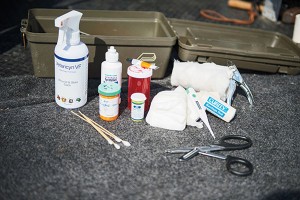 With bird seasons well underway, this is a good time for suggestions on how to deal with those emergencies you're bound to encounter in the field.
With bird seasons well underway, this is a good time for suggestions on how to deal with those emergencies you're bound to encounter in the field.
Let's first talk about vital signs and how to check your dog's pulse, temperature and breathing rate, as well as what's normal in each case. I suggest you read this and then practice on your dog; you'll gain confidence, accuracy and have a better idea of what's normal for your dog at different levels of activity.
The average normal temperature for a healthy dog at rest should be 101 degrees Fahrenheit plus or minus half a degree. Although during hard work it's not uncommon to find his temperature at 104 or 105 degrees, it should return to normal once the dog has rested.
In general, higher temperatures may indicate infection, heat stress or other disorders while a lower than normal temp is often a sign of shock or hypothermia. Temperature is taken with a rectal thermometer.
Before insertion, be sure to shake the thermometer down to 95 degrees and lubricate it with petroleum jelly. Lift and hold the dog's tail while you insert the thermometer with a gentle twisting motion. For accurate readings, the thermometer should stay in place 30 to 60 seconds; during this time continue to hold the dog's tail and the thermometer.
Remove the thermometer, wipe it clean and read. You may want someone to help hold the dog while taking his temperature, and if he puts up a struggle don't chance injury.
Normal pulse for an adult dog is 70 to 160 heartbeats per minute, while a puppy's may go up to 220. The easiest way I've found to check pulse is on the femoral artery, which runs down the inside of the back leg.
Use your fingertips to locate the artery high up near the center of the thigh where it meets the body. You can do this while the dog is standing, but you may wish to lie him on his back. Once you've located the artery, count the number of heartbeats in a 15-second period and multiply your count by four to determine the heart rate or beats per minute.
Heart rate is a good way to monitor your dog's progress during exercise. In general, a dog in "field condition" has a lower heart rate during exercise and faster recovery times than during off season.
Breathe Easy
The normal breathing rate for dogs ranges from 10 to 30 breaths per minute. Realize that after activity panting at an accelerated rate is normal. Simply watch or feel his chest as it expands, taking air into the lungs, and count the number of breaths in a 15 second period, again multiplying the count by four to determine the "respiratory rate." Note: An injured dog's respiration can be hard to determine, and vets suggest holding a feather or tissue near the nose to notice even the slightest breath.
Muzzle an injured dog before tending to them. Even the best mannered and well-trained dogs will bite when injured. A muzzle keeps the dog from nipping or biting, but shouldn't be overly tight. They are sold commercially, but a flat strip of cloth or gauze will do. Loop the material over the nose just behind the canine teeth, catching the lower jaw, then bring the ends down under and make a half hitch to hold the jaws together. Next, bring the ends around the neck just below his ears and tie off behind his head in a bow knot.
A bruise or closed wound shouldn't be underestimated. Because the skin and hair coat may be intact, this type of wound can be deceiving. Whether caused by a direct or glancing blow, the full extent of the injury can go undetected. If your dog shows pain and swelling, along with a warm feeling to the area, it probably warrants a veterinarian's examination. In the meantime, clean the area with cold water and apply ice packs.
Open wounds are more serious. Substantial loss of blood can be life-threatening; muscles, tendons, nerves are often severed; internal organs might be damaged and infectious are possible.
Even though some wounds aren't serious to begin with, if unattended, infection can cause complications, pain and swelling. It's a good idea to check your dog over at the end of the day. Look for small cuts or scratches, clean them with antiseptic soap like betadine, then apply a topical antibiotic ointment.
When possible, see your vet within 24 hours. In the case of severe wounds involving considerable blood loss, your primary responsibility is to control the bleeding by applying a pressure bandage or gauze pads directly on the wound until you get to the vet. Only use enough pressure to stop the bleeding, not so tight that it stops circulation.
BROKEN BONES
Most breaks occur in the legs. Usually the leg hangs unnaturally; the dog won't put any weight on it or shows extreme lameness. Any movement can cause sharp bone ends to damage blood vessels, tissue, or skin, and with compound fractures there's the added danger of infection.
 I was surprised to find most veterinarians and pet care books recommend we do not attempt to splint broken bones. An incorrectly placed splint can cause further damage. Yet they do recommend supporting the leg in some way to avoid added damage while transporting. A loosely wrapped towel or sweatshirt will do the job.
I was surprised to find most veterinarians and pet care books recommend we do not attempt to splint broken bones. An incorrectly placed splint can cause further damage. Yet they do recommend supporting the leg in some way to avoid added damage while transporting. A loosely wrapped towel or sweatshirt will do the job.
If the broken bone has punctured the skin, take measures to stop bleeding and cover the wound to keep it as clean as possible on the way to the vet.
The highest incidence of severe trauma results from dogs being hit by cars. Broken bones and open wounds are likely, but minor when compared to the probability of internal bleeding and shock.
When moving the dog to safety, never pick him up by the waist or chest as you could force a broken rib through a lung or other organ. Put a rug or blanket on the ground close behind the dog and drag him on to it by the loose skin of his neck and back, then you and a friend can lift the dog to safety using the rug as a hammock/stretcher.
Once in a safe area, check to see the dog's airway is clear, pull the tongue out and to the side, check for blood or other material and clear the mouth and throat. Quickly take measures to control bleeding and otherwise prepare the dog for immediate transport.
If the chest cavity is punctured, identified by a sucking sound at the wound, you have to seal it so the dog can breathe. Cover the area with a cloth and apply pressure until the noise stops, then wrap with tape. If there's an object protruding from the hole, leave it for your veterinarian to remove. While transporting, never give the dog food or water. Cover him to maintain body heat as a measure against shock.
Shock is lack of adequate blood flow. The body is trying to correct this loss by speeding up the heart, constricting vessels and conserving fluid in circulation. If allowed to continue, vital organs begin to shut down for lack of oxygen, shock becomes self-perpetuating and can cause death.
Shock can be caused by dehydration, heat stress, infections, hemorrhage and related trauma. Symptoms include a drop in body temperature, lethargy, cold extremities, pale gums and mucus membranes and a rapid but weak pulse.
Once diagnosed, remove the cause if possible, calm the dog and help him assume a comfortable position while he's transported.
HEAT STRESS
Overworking fat or poorly conditioned dogs, not being attentive to fatigue or lack of water or shade are some examples, but the leading cause of death by heat stress is leaving dogs unattended in cars on warm days.
Early symptoms are less body and tail action and increased panting. As body temperature elevates, you'll notice aggravated panting, salivation, a panicky expression, gums becoming dark red and problems with coordination.
Flush the dog's mouth with cool water, removing saliva and allowing the dog to drink small amounts of clean, cool water. Immerse the dog in cool water if possible or at least use wet rags, or available water to cool the under parts, ears and tongue.
Cooling these areas cools circulating blood, which in turn helps to lower core temperature. If available, an alcohol bath aids in this cooling process. With advanced cases, seek a veterinarian's assistance.
Your dog's eyes should be checked periodically during the hunt, or at least at the end of each day. Weed seeds and debris lodged under the lids can cause irritation or corneal ulcers.
Pay special attention to the "third eyelid." It's actually a second lower lid, and in the inside corners there are likely signs of trapped debris.
If debris is present, try flushing it free with a stream of saline. If that doesn't work, try to blot it out with a cotton ball soaked in saline. Caution: Don't wipe, but only blot softly, as wiping can scratch the eye, causing more damage. When the eye is cleared, apply steroid-free antibiotic ophthalmic ointment two or three times a day.
Be Prepared
 Your veterinarian or pharmacy should have most of the first-aid items you will need. Check your hardware store for a small tackle box to keep everything organized. Items should include a roll of gauze, gauze pads, adhesive tape, betadine scrub, betadine ointment, scissors, a nail clipper, forceps, saline solution and dispenser, cotton balls, Q-tips, rectal thermometer, and steroid-free ophthalmic antibiotic ointment.
Your veterinarian or pharmacy should have most of the first-aid items you will need. Check your hardware store for a small tackle box to keep everything organized. Items should include a roll of gauze, gauze pads, adhesive tape, betadine scrub, betadine ointment, scissors, a nail clipper, forceps, saline solution and dispenser, cotton balls, Q-tips, rectal thermometer, and steroid-free ophthalmic antibiotic ointment.
There are also a number of excellent kits commercially available if you prefer to buy one "ready-made."
I hope these tips will serve as an everyday aid to maintaining your dog's health and well-being at home and while training and hunting, and that you're never faced with severe problems.






